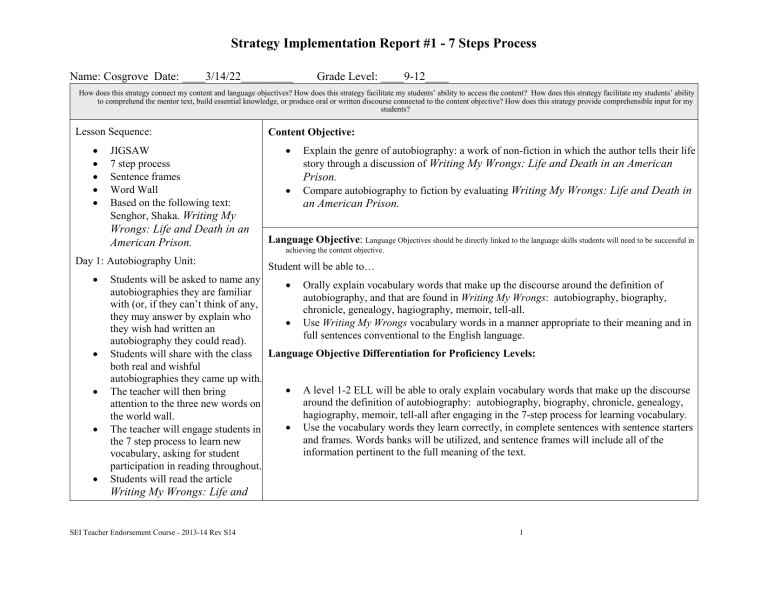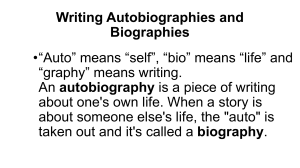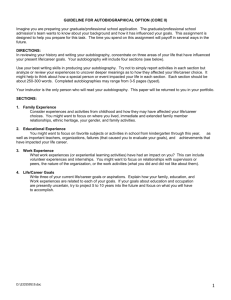
Strategy Implementation Report #1 - 7 Steps Process Name: Cosgrove Date: ____3/14/22_________ Grade Level: ____9-12____ How does this strategy connect my content and language objectives? How does this strategy facilitate my students’ ability to access the content? How does this strategy facilitate my students’ ability to comprehend the mentor text, build essential knowledge, or produce oral or written discourse connected to the content objective? How does this strategy provide comprehensible input for my students? Lesson Sequence: JIGSAW 7 step process Sentence frames Word Wall Based on the following text: Senghor, Shaka. Writing My Wrongs: Life and Death in an American Prison. Day 1: Autobiography Unit: Content Objective: Explain the genre of autobiography: a work of non-fiction in which the author tells their life story through a discussion of Writing My Wrongs: Life and Death in an American Prison. Compare autobiography to fiction by evaluating Writing My Wrongs: Life and Death in an American Prison. Language Objective: Language Objectives should be directly linked to the language skills students will need to be successful in achieving the content objective. Student will be able to… Students will be asked to name any Orally explain vocabulary words that make up the discourse around the definition of autobiographies they are familiar autobiography, and that are found in Writing My Wrongs: autobiography, biography, with (or, if they can’t think of any, chronicle, genealogy, hagiography, memoir, tell-all. they may answer by explain who Use Writing My Wrongs vocabulary words in a manner appropriate to their meaning and in they wish had written an full sentences conventional to the English language. autobiography they could read). Language Objective Differentiation for Proficiency Levels: Students will share with the class both real and wishful autobiographies they came up with. A level 1-2 ELL will be able to oraly explain vocabulary words that make up the discourse The teacher will then bring around the definition of autobiography: autobiography, biography, chronicle, genealogy, attention to the three new words on hagiography, memoir, tell-all after engaging in the 7-step process for learning vocabulary. the world wall. Use the vocabulary words they learn correctly, in complete sentences with sentence starters The teacher will engage students in and frames. Words banks will be utilized, and sentence frames will include all of the the 7 step process to learn new information pertinent to the full meaning of the text. vocabulary, asking for student participation in reading throughout. Students will read the article Writing My Wrongs: Life and SEI Teacher Endorsement Course - 2013-14 Rev S14 1 Strategy Implementation Report #1 - 7 Steps Process Death in an American Prison in a popcorn reading circle. Targeted Tiered Vocabulary 1 from Mentor Text or Source P0F P Tier 2 & Tier 3 words should be integrated into student product/assessment. Tier 1 words Tier 2 words Basic words most children know in their primary language: may include connectors or compounds Story Life author Essential to comprehension: i.e., process & transition, specificity, sophistication polysemy, transitional terms, idioms, clusters, cognates… Tier 3 words Low frequency, content specific, typically found in a glossary in the back of a text Aegis Deconstruction Psychoanalysis Radioactive exploited nonfiction discourse composition 7 steps Script for Implementing 7 Steps to Better Vocabulary This is a pre-reading/pre-teaching vocabulary strategy to aide students in comprehending the target mentor text. 1 For more information on Tiered vocabulary, see Beck & McKeon (1985), Calderón (2007). SEI Teacher Endorsement Course - 2013-14 Rev S14 2 Strategy Implementation Report #1 - 7 Steps Process There should be 100% participation on all steps. Steps 1-7 must be completed in order and during the same session. Step 6 should be timed for 1 minute. Ping Pong style: students taking turns using the word in a sentence. Step 7 is the accountability step. Remind students that they will be using the words as they summarize orally what they read, as they discuss what they read, and later in their writing. There should be no writing in the pre-teaching of vocabulary during 7 steps. Before implementing, the teacher will: ✓ preview the mentor text, tier the vocabulary and choose the words to pre-teach. ✓ choose 3-5 words taken directly from the mentor text. ✓ have the dictionary definitions ready to go. ✓ have sentence starters/stems/frames ready for Step 6 as needed. Word 1 Steps Word:__exploited_______ Tier: ____2____ Why you picked it: It describes a major theme in the autobiography Writing My Wrongs: Life and Death in an American Prison, that is integral to understanding the book as a “life story” (i.e. an autobiography). 1. Teacher says the word. Student repeats. 1. Exploitation, Exploitation, Exploitation. 2. Teacher states the word in context from the mentor text. 2. “Miko was making a lot of money off of my hustling and dedication, but as I sat in his spots twenty-four hours a day, I never would have guessed that I was being exploited. All I knew was that I stayed fresh and my pockets were fat. I didn’t have long-term plans or an exit strategy. All I cared about were the shoes and clothes I wore and the things other people thought about me” (Senghor, 53). A student volunteer will be solicited to read this out loud to the class. 3. Teacher provides the dictionary definition(s). 3. The action or fact of treating someone unfairly in order to benefit from their work. 4. Explains meaning with student-friendly definitions. 4. When someone takes your hard work for their own. U U SEI Teacher Endorsement Course - 2013-14 Rev S14 A student will be called on to read this out loud for the class. 3 Strategy Implementation Report #1 - 7 Steps Process 5. Highlights features of the word: polysemous, cognate, tense, prefixes, etc. 6. Engages students in activities to develop word/concept knowledge. The 1 Minute TTYP Exploited (past tense of exploit – to use unfairly). ex- 1. a prefix meaning “out of,” “from,” and hence “utterly,” “thoroughly,” and sometimes meaning “not” or “without” or indicating a former title, status, etc.; freely used as an English formative: exstipulate; exterritorial; ex-president (former president); ex-member; ex-wife. 6. Students take turns sharing what “exploit” means in their own words and using it correctly in a sentence. (Turn to Your Partner) & use the word 5-6 times in complete thoughts or sentences, ping pong style. Ping pong style turn taking in the exchange so that no one partner dominates Once in a while, teachers can check in by asking, “Who wants to tell me what your partner said?” 7. Teacher reminds and explains to students of how new words will be used. There is NO writing by students at this time. This is where the teacher explains that students should use this word in their homework, classwork, reading summaries, etc. 7. For homework, students will write two sentences using the word; one in which it is used correctly, and other showing an example that illustrates the words meaning. Ex) To be exploited is to be taken advantage of unfairly. An example of an organism with exploitation is if someone steals your homework and takes credit for it Word 2 Steps Word:___Radioactive_______ Tier: ___3_____ Why you picked it: It is used to describe the author’s life, and must be understood to understand his occupation for a significant part of the memoir. 1. Teacher says the word. Student repeats. SEI Teacher Endorsement Course - 2013-14 Rev S14 1. Radioactive, radioactive, radioactive 4 Strategy Implementation Report #1 - 7 Steps Process 2. Teacher states the word in context from the mentor text. 2. “My life began to glow with problems, just like the facility in which I worked. I became radioactive to family and friends, and felt like I might go nuclear.” (Writing My Wrongs, 93) A student will be called on to read this for the class 3. Teacher provides the dictionary definition(s). U 3. having or producing powerful and dangerous energy that comes from the breaking up of atoms. U A student will be called on to read this for the class 4. Explains meaning with student-friendly definitions. 4. Describes a process in which harmful particles attack the body. In our usage it is metaphorical, and just means something along the lines of untouchable. 5. Highlights features of the word: polysemous, cognate, tense, prefixes, etc. 5. the prefix radio is to be ignored, it doesn’t hold a polysemous meaning of “the radio” that plays music. 6. Engages students in activities to develop word/concept knowledge. The 1 Minute TTYP 6. Students take turns sharing what a radioactive is in their own words and using it correctly in a sentence. (Turn to Your Partner) & use the word 5-6 times in complete thoughts or sentences, ping pong style. Ping pong style turn taking in the exchange so that no one partner dominates Once in a while, teachers can check in by asking, “Who wants to tell me what your partner said?” 7. Teacher reminds and explains to students of how new words will be used. There is NO writing by students at this time. This is where the teacher explains that students should use this word in their homework, classwork, reading summaries, etc. SEI Teacher Endorsement Course - 2013-14 Rev S14 7. For homework, students will write two sentences using the word; one in which it is used correctly, and other showing an example that illustrates the words meaning in the context of Writing My Wrongs. Ex) To be radioactive is to be a harmful form of energy. An example of radioactive as it is used in the autobiography is: that person is toxic; he is radioactive. 5 Strategy Implementation Report #1 - 7 Steps Process Reflection on the strategy implementation: Each response should be a short paragraph that includes sufficient details. How did this strategy help my ELLs achieve the content and language objectives? The 7-step strategy was an interactive way to introduce ELL students to several key vocabulary terms that directly connected to the content and language objectives of the unit: prokaryotic and eukaryotic cells. By leading students through learning the meaning and usage of each vocab words in 7 different ways, students were left with a much deeper understanding of the biology terms than they would have gotten from only teaching them the definition alone. Following this strategy with the sentence frames activity gave students a chance to practice applying the vocab terms they had learned applying this aspect of biology. How did this strategy help the ELLs in my classroom to produce academic language and discourse? The students said they liked the sentence frames because it helped “warm up their thinking”. They were able to keep writing after the sentence frames and be more productive in the assignment. The students also used the bilingual diagram for the assignment and were able to compare the Spanish and English words and were able to recognize that nova and nueva have the same root. This was not one of the words we focused in on, but at least it got everyone to think about root words. To increase my ELLs’ engagement and interaction, these are the things I would change the next time I try this strategy: I think I need to find a better way for step 1 of the seven steps. The students do not like doing a call and response in a high school class. However, they do still need to learn pronunciation of the word. I might try to break it down into syllables and have someone who feels comfortable try saying it first, then I say it correctly, then everyone tries it. SEI Teacher Endorsement Course - 2013-14 Rev S14 6

